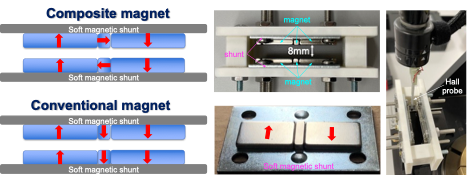Data storge is the foundation of contemporary life in a digital universe. The global data center storage capacity has grown by 25-fold from 2010 to 2018[i]. From 2018 to 2025, the total amount of new data is forecasted to grow from 33 to 175 zettabytes (1021 bytes) globally[ii]. Despite fast growth of flash memory devices in smart phones, portable and desktop computers, a majority of data are stored in magnetic hard disk drives in the cloud and servers[iii].
Magnetic hard disk drives use voice coil motors to move the read/write heads mounted at the tips of the actuator arms to position the heads on the rotating disks (platters)[iv]. The name of the voice coil motor originates from the fact that the working principle of this type of motor is the same as that of the voice coil in a louder speaker. The movement of the actuator arms is achieved by changing the direction of the electric current in the coil inside a well-defined magnetic field profile generated by a pair of permanent magnets. The strength and spatial gradient of the magnetic field determine the strength of the torque generated by the voice coil motor, thus determining the range and speed of the movement of the actuator arms. The latter are critical to the hard drive’s data storage capacity and read/write speed.
To meet the ever-growing need for high-capacity disk drives, the number of platters in a drive continues increasing, leading to the increase of the number of heads, actuator arms, and total drive weight. To enable the same access speed and acceleration of the actuator arm, increase of the air gap magnet field strength or the voice coil current is needed. An immediate solution to increasing the air gap field strength is to increase the permanent magnet thickness. However, the field strength does not increase linearly with the increase of the magnet thickness. The thicker the magnets, the less the gain of the field strength from the increased thickness, resulting in higher magnets cost and drive weight.
By arranging permanent magnets in an array with a special configuration, Halbach array can enhance the magnetic field on one side and reduce the field on the other side. A composite magnet structure based on the Halbach effect has been studied for the hard disk drive application under a recent collaboration between International Business and Technology Service Corporation (IBTSC) at St. Paul, Minnesota and Lab Magnetics Inc., a Quadrant Company, at San Jose, California. Design optimization based on micromagnetic and finite element method (FEM) simulations was conducted by IBTSC, followed by proof-of-concept prototype building and testing by Lab Magnetics.
Shown in Fig. 1 is the schematics of the composite magnet solution vs. conventional magnet configuration, images of the prototype built for air gap magnetic field testing, and the air gap magnetic field-testing setup with a 3D Magnetic Field Mapper, Senis Model MMS-1A-RS.

Fig. 1 Schematics of the composite magnet solution vs. conventional magnet configuration, images of the prototype built for air gap magnetic field testing, and the air gap magnetic field-testing setup.
The test result shown in Fig. 2(a) indicates that the magnetic field is ~5% stronger in the vicinity of the center magnet piece for the composite magnet solution than the conventional magnet configuration. This leads to a net torque gain by the composite magnet solution in the entire operation range of the voice coil motor, as shown in Fig. 2(b). The torque ratio of the composite to conventional magnet solutions as a function of the position of the read/write heads along their path is plotted in Fig. 3(c). There are 3% to 7% net torque gains by the composite magnet solution, with the largest gain at the extreme ID and landing zone.

Fig. 2 (a) Magnetic field strength measured in the air gap 4mm above the magnet surface; (b) the calculated voice coil motor torque based on the measured air gap field strength for a given coil structure with a given current normalized to the composite magnet solution; (c) the rotational torque ratio of the composite to conventional magnet solutions with the same motor structure and driving current.
Further improvement from the prototype built in the current study is expected by optimizing the geometry of the magnets and adding more individual magnets to the composite structure. The cost of manufacturing the composite magnets will be higher than that of the conventional ones due to the added steps of assembling individual magnets with different magnetization directions in the specific way. However, when increasing the magnet thickness becomes less and less effective to increase the disk drive’s capacity, the performance gain from the composite magnets may overcome their manufacturing cost.
[i] Recalibrating global data center energy-use estimates, Science 367 (2020) 984-986
[ii] The U.S. Datasphere: Consumers Flocking to Cloud, ©2019 IDC, #US44601919
[iii] Domain wall memory: Physics, materials, and devices, Physics Reports 958 (2022) 1-35
[iv] How Hard Disk Drives Work, by Animagraffs created in partnership with Seagate (2020) https://animagraffs.com/hard-disk-drive/
